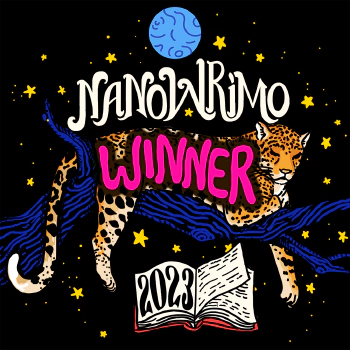I did it, finished, completed the challenge, and couldn’t be more chuffed. Completing 50,000 words in 30 days is a feat I’ve been trying to accomplish for over ten years. I decided this year to not only reach the end of the challenge but collect all of the badges you can over the month-long global event. I managed all but one of the badges, but for real folks, check out the video below of the draught manuscript, all those words came out of my head.
There are three things that I believe helped me to finish the challenge this year. In this post, I will tell you a bit about them.
Planning
There are two types of writers in this world (so they say): Planners and Pantsers. As you can imagine, planners start with lots of preparation, an outline, a timeline, the characters and even the ending. They begin on Nov 1st, knowing what they will write and set about it with gusto.
Pantsers, on the other hand, start with a blank slate and just write.
Turns out I’m a hybrid, a Plantser. This year, to help me proceed, I worked out the story that I wanted to tell, had an idea of some of the characters and even used the author of Save the Cat: The Last Book On Screenwriting You’ll Ever Need Blake Snyder’s beat sheet to help me organise and pace the story. When I sat down to write, I felt that Doug Rennie’s article Founding a Fiction Factory helped me more.
Yes, I had the outline in my head, but the technique of sitting down and writing scenes contributed most to this year’s success. I love free writing, where you get a topic, picture or sound and write whatever comes into your head in association with that prompt. I treated each writing session as a free-write, the prompt being where I needed to take the story next or a conversation between characters on an element to move the story forward. Sometimes, I needed to flesh out a backstory to make sense of something I’d written the day before. Other times, I needed to find a way to link seemingly unrelated incidents to join a thread. It didn’t matter; working in this way meant 90% of the time I found a source for the free-write and, thus, the scene.
Single-minded determination
The second thing that helped me was adopting a single-minded deterministic approach. The challenge is to complete 50,000 words in thirty days. On average, this works out to a minimum of 1667 words daily to achieve it. Now you don’t have to do it like that. If you have a job, kids, or a family to look after, reaching that can be an extra challenge. I didn’t manage to do the minimum every day. There were days when pulling words from my head was an almighty struggle. I did, however, commit to writing every day. My lowest word count was 90 words. This was the entry for that day.
I am really not sure if I can write anything today about the story. My brain is fried, and there’s nothing really coming to mind. I’m hoping that later on I will be able to resurrect the writing flame and get some story words out. But at the moment I am just doing this as an interlude, so that I can keep up my word count streak. Even if Ade has somewhere to go today, I’m not sure I’m the one that can take her there.
Thankfully, my daily average by the end of it was over 1671 words per day. I realised I could, on average, write 500 words in a 20-minute sprint, which brings me to the third thing that helped me to complete this year’s challenge.
Writing in a Community
Every year during NaNoWriMo, events are arranged so you don’t have to write alone. The meetups are held in coffee shops, sometimes cultural buildings such as London’s Southbank, and many cafes or pubs. As well as in-person meetups, Discord servers and forums are online to provide a space to chat, do writing sprints, and hang out with like-minded people from early morning to late hours at night.
This year, I joined the Discord for the Kent Nanos and found support, inspiration, and general camaraderie. Sadly, I didn’t get to any of the face-to-face meetups. Still, the online community helped me maintain when motivation was low, and doubts about finishing were high. They weren’t the only ones, though. I have a community of artists around me who prop me up with encouragement and a boost of creative energy and inspiration. This helped enormously, particularly the last weekend when I was staring at a deficit of nearly 12,000 words.
The story continues
I’ve completed the challenge and wrote 50,141 words, finishing at 10:07pm on Nov 30th, but the story still needs to be completed. During the process, the story pivoted a bit. I realised some of the threads didn’t work, and the free writes were taking me in a different direction. I like the organic nature in which the story developed, so I will now go back and read over what I wrote, discard the bits that don’t work, and attempt to release threads that are not strong enough. There are whole passages where I did a lot of telling and not much showing (a writing technique that makes reading more exciting and imaginative for readers). One thing is clear: NaNoWriMo is great as a starting point for your first draft, but the real work begins after Nov 30th.
Let the edits begin.


